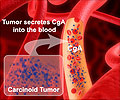- Polymersomes are emerging as a powerful tool in drug delivery.
- Polymersomes are a class of artificial vesicles that enclose a solution.
- Polymers shift their shape according to the different conditions around them to form tubular structures that can encapsulate drugs.
A research team at University of New South Wales have developed a way to control the shape of polymer molecules so they self-assemble into non-spherical nanoparticles. This advancement could improve the delivery of toxic drugs to tumors.
"Most biological structures like cells, bacteria and viruses come in a variety of shapes including tubes, rods, and squashed spheres, or ellipsoids. But it has proved very difficult for scientists to synthesize particles that are not perfectly round. Our breakthrough means we can predictably make smart polymers that shift their shape according to the different conditions around them to form tiny ellipsoidal or tubular structures that can encapsulate drugs” Professor Pall Thordarson said.
Controlling the shape of the polymersome with water
The scientists worked with polymer molecules that contain a water-soluble portion and a non-water-soluble portion, and which self-assemble into round, hollow structures, known as polymersomes, in solution.
The UNSW team's novel chemical design is to add a non-water-soluble perylene polymer group to the membrane of the polymersome. The shape and size of the polymersome can then be adjusted by changing the amount of water in the solvent.
"It's a straightforward but elegant solution which we feel has great potential for making a wide range of complex polymer structures inspired by nature," says Professor Stenzel.
References:
- Chin Ken Wong, Alexander F. Mason, Martina H. Stenzel, Pall Thordarson. Formation of Non-Spherical Polymersomes Driven by Hydrophobic Directional Aromatic Perylene Interactions, Nature Communicationsdoi:10.1038/s41467-017-01372-z













